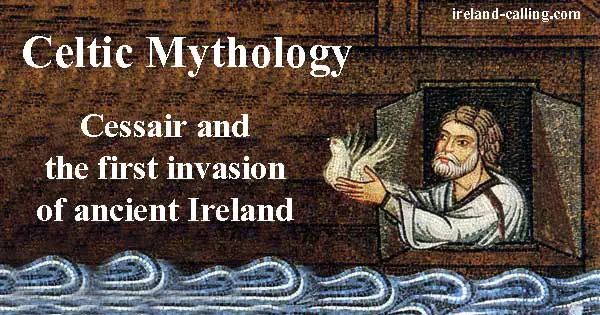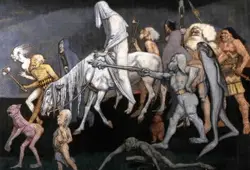The Book of Invasions attempts to recount the history of Ireland from the time the first settlers arrived. It was compiled by scholars in the 11th century and was a considered as a reliable history for hundreds of years.

However, scholars today regard it as almost entirely mythical. Its stories have become a major part of Irish folklore.
According to the Book of Invasions, the first people to invade Ireland were implored to do so by a woman called Cessair. Cessair was the granddaughter of Noah from the bible. She becomes aware of the impending flood and persuades her father Bith and his people to flee to the western limits of the known world to escape the rising waters.
They set out but two of their ships are lost at sea. Only three men and 50 women including Cessair survive and land in Ireland. The women are divided between the three men but they do not survive for long.
The Flood eventually claims them all except a man called Fintán mac Bóchra. He survives hiding for a year under the water in a cave which came to be known as Fintan’s Grave. He lived for 5,500 years after the Flood and was referred to as the White Ancient.
Partholón and the second invasion of Ireland
The second settlement in Ireland was led by Partholón. Like Cessair and the Gaels who settled in Iberia, Partholón was a descendant of Noah.

Partholón arrived in Ireland 300 years after the Flood with his three sons and their tribesmen. They only enjoy a brief period of peace, however. Within 10 years of arrival, they find themselves under attack from a fierce tribe of seafarers called the Fomorians – a semi-divine race said to represent chaos.
The Partholónians fight off the Fomorians but they still don’t find peace. Soon they are wiped out by plague. The Book of Invasions recounts that 5,000 men and 4,000 women lost their lives and were buried on the Plain of Elta, to the south west of Dublin.
The area is known in Ireland today as Tallaght, which means plague grave.
The Nemed invasion and the Fir Bolg
The next settlement in Ireland involved the Nemedians. Nemed was the great grandson of Partholón’s brother so the connection with Ireland was already established.
Nemed and his followers arrived in Ireland 30 years after the Partholónians were wiped out by plague.
They too have a difficult time and find themselves under constant attack from the Fomorians.
Eventually, both sets of warriors are killed in a great sea battle. The remaining Nemedians die when a second great flood covers the land. The few remaining survivors flee for their lives. One group settles in Greece where they are treated as slaves.
More than 200 years after the death of Nemed, they manage to escape and flee to Ireland. These people become known as the Fir Bolg. Although their story is surrounded by myth, it’s thought they may be based on a real group of people. They were said to have introduced the idea of kingship and systems of justice to Ireland.
Their newfound freedom and civilisation was short lived, however. They enjoyed only 37 years of peace before they find themselves under attack from Ireland’s most famous mythological invaders, the Tuatha Dé Danann.